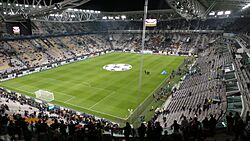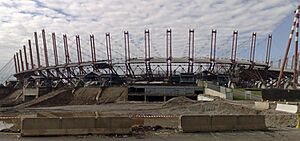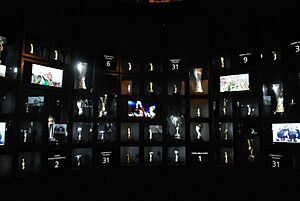Juventus Stadium facts for kids
|
Allianz Stadium
|
|

|
|
| Address | Corso Gaetano Scirea 50, 10151 |
|---|---|
| Location | Turin, Italy |
| Coordinates | 45°6′34″N 7°38′28″E / 45.10944°N 7.64111°E |
| Public transit | |
| Owner | Juventus Football Club S.p.A. |
| Operator | Juventus Football Club S.p.A. |
| Executive suites | 84 |
| Capacity | 41,507 seated |
| Record attendance | 41,507 vs. Inter Milan (26 November 2023, Serie A) |
| Field size | 105 m × 68 m (344 ft × 223 ft) |
| Surface | Grass |
| Scoreboard | LCD |
| Construction | |
| Broke ground | June 2009 |
| Built | 2009–2011 |
| Opened | 8 September 2011 |
| Construction cost | €155 million |
| Architect | Hernando Suárez Gino Zavanella Giorgetto Giugiaro |
| Structural engineer | Francesco Ossola Massimo Majowiecki |
| Tenants | |
| Juventus FC (2011–present) Italy national football team (selected matches) |
|
The Allianz Stadium is a super cool football stadium in Turin, Italy. It's also known as Juventus Stadium. This stadium is the home ground for the famous football team, Juventus FC. Since July 2017, it's been called Allianz Stadium because of a sponsorship deal.
This stadium is special because it was the first one in Italy to be owned by a football club. It's built on the same spot where Juventus's old stadium, the Stadio delle Alpi, used to be. The Allianz Stadium is one of only four stadiums in Italy that has a top-level UEFA Category 4 rating. This means it meets the highest standards for football venues!
It opened its doors at the start of the 2011–12 football season. With 41,507 seats, it's the sixth-largest football stadium in Italy. It's also the biggest in the Piedmont region. The stadium has a modern design and no barriers that block your view.
Juventus played their first game here on September 8, 2011. It was a friendly match against Notts County, which ended in a 1–1 draw. The first official goal was scored by Stephan Lichtsteiner a few days later. Juventus has had amazing success here, losing only three of their first 100 league matches!
The stadium has hosted some big events. These include the 2014 UEFA Europa League Final, the 2021 UEFA Nations League Finals, and the 2022 UEFA Women's Champions League Final. Around the stadium, you can also find the J-Museum, the J-Medical center, and a shopping mall.
Contents
Why a New Stadium Was Built
Juventus used to play at the Stadio delle Alpi, which was built for the 1990 FIFA World Cup. But fans didn't really like it. It was far away and had a running track around the field. This made it hard to see the game clearly. Even though Juventus is Italy's most popular team, the stadium was often half empty.
In 2002, the club bought the stadium from the city. This was a popular decision with the fans. Juventus wanted a stadium where fans could feel closer to the action. So, after the 2006 Winter Olympics, they started planning a new, more exciting home.
The new stadium cost about €155 million to build. It has modern features like special VIP boxes. When it was finished, Juventus became the only team in Italy's top league, Serie A, to own its own stadium. This was a huge source of pride for the club.
Building a Green Stadium
The Allianz Stadium was built with the environment in mind. The builders used special technologies to make sure it didn't harm the planet. They wanted to use less energy from sources that can run out.
Here's how they made it eco-friendly:
- Solar Power: The stadium uses solar energy from photovoltaic panels to make its own electricity.
- Heating System: It uses a special heating system to warm rooms, changing rooms, kitchens, and even the football field.
- Hot Water: Solar panels also help heat water for the changing rooms and restaurants.
- Recycling: All the concrete from the old Stadio delle Alpi was recycled and used for the new stadium. Other materials like steel and copper were also reused. This saved a lot of money and helped the environment.
- Water Saving: The stadium collects rainwater to use for watering the field. This cuts down on how much fresh water is needed.
These efforts help reduce pollution and save natural resources.
Stadium Name and Opening
Juventus signed a deal with a company called Sportfive. This company had the rights to name the stadium from 2011 to 2023. Later, on July 1, 2017, the stadium officially became known as the Allianz Stadium. This name will be used until June 30, 2030.
The stadium officially opened on September 8, 2011. There was a friendly match against Notts County. This team was chosen because Juventus's black and white stripes were inspired by Notts County's jerseys! The game ended in a 1–1 draw.
Cool Features and Services
Juventus Premium Club
The stadium has 3,600 special "premium" seats and 64 sky boxes. If you're part of the Juventus Premium Club, you get special entry, comfy seats with your own TV, access to fancy restaurants and bars, snacks during the game, and reserved parking. You can also visit the J-Museum!
Stadium Tours
Want to see behind the scenes? You can take a 70-minute guided tour of the stadium every day. You'll get to see the dressing rooms, the facilities, the museum, and even walk near the pitch! These tours started in November 2011.
Area12 Shopping Centre
Right next to the stadium is Area 12, a big shopping center that opened in October 2011. It has over 60 shops, places to eat, and a huge Juventus Store. This store is the biggest sports club shop in Italy! It's a great place to find all your Juventus gear.
J-Museum
The Juventus Museum, or J-Museum, opened in May 2012. It's a modern museum that uses lots of technology to tell the story of the club. You can see all of Juventus's trophies and learn about its history. It's a very popular spot for visitors!
J-Medical
In March 2016, Juventus opened its own medical center called J-Medical. It's located right in the stadium. This center has special clinics, operating rooms, and a rehabilitation area. It helps the local community with healthcare and also checks on Juventus players. For example, Miralem Pjanić had his medical check-up here before joining the team in 2016.
Major Events Hosted Here
2014 UEFA Europa League Final
In 2012, UEFA announced that the Allianz Stadium would host the final of the 2014 UEFA Europa League. This was the first time Turin hosted a final for a major European club competition. Sevilla from Spain won the match against Benfica from Portugal after a penalty shootout.
2021 UEFA Nations League Finals
The stadium was also one of the venues for the 2021 UEFA Nations League Finals. This was another big international football event held in Turin.
2022 UEFA Women's Champions League Final
In 2020, UEFA announced that the Allianz Stadium would host the final of the 2022 UEFA Women's Champions League. This shows the stadium's importance for both men's and women's football.
J-Village: A Club Hub
Juventus has also developed a large area near the stadium called J-Village. This project started in 2010 and has created a whole hub for the club.
J-Village includes:
- JTC (Juventus Training Center): This is where the first team trains.
- Juventus Head Office: The club's main offices are now here.
- J-Hotel: A four-star hotel with 138 rooms. Juventus owns part of it.
- ISE International School: A school for students.
- Concept Store: Another shopping area.
This whole area helps Juventus grow and provides many services for the club and its fans. The new Juventus head office opened in July 2017, and the J-Hotel opened in August 2019.
See also
 In Spanish: Juventus Stadium para niños
In Spanish: Juventus Stadium para niños




